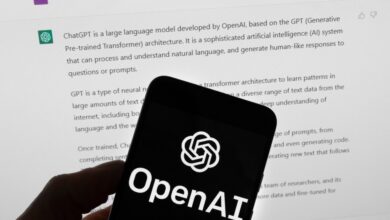40% of Large Organizations to Adopt Generative AI in 2024: Report


Analytics Insight, a leading print and digital publication company, published a detailed report on “Adoption of Generative AI in Enterprises 2024,” whereby it was deduced that generative AI technologies brought intense modifications into the corporate world. The insight was based on a global, cross-industry survey of 1,000 executives. It is powered by the profound expertise of Artificial Intelligence, technology implementation, strategy, and risk management.
Moving deeper into 2024, one would be convinced that generative AI is not a fleeting trend but forms a very important cornerstone in the evolution of enterprise operations.
The report highlighted the strong, fast integration of generative AI in most digitally facing industries with servlet, fast technology advancements, intense data availability, improved computational powers at low costs, and high-speed internet, which ensures that the adoption of generative AI would be inevitable across sectors.
All these forces have combined to make generative AI one of the key game-changers in defining new ways of doing business, proffering novel opportunities for growth and interaction with technology.
A Quantitative Leap in AI Adoption
A quantitative analysis brought out by the “Adoption of Generative AI in Enterprises 2024” report from Analytics Insight clearly brings out the trend: about 75% of the identification by senior leaders and executives recognize generative AI as the most influential emerging technology across different industries.
This sentiment is also replicated in strategic plans, where around 43% of enterprises are set to roll out their first generative AI solutions within the upcoming two years.
Adopting Generative AI Across Company Sizes
The results of the survey conducted by Analytics Insight are almost directly proportional to the size of companies with regard to generative AI. Statistics show that 40% of large enterprises, who are leading in terms of technology amalgamation, have already integrated AI into traditional operations. Medium-sized companies follow this with 30% of the adoption, small businesses with 29%, and then micro-enterprises with 22%.
Variation in the rate of adoption among companies of different sizes is evident but is not ‘sharp’, and can be interpreted as a general trend towards willingness to accept the potential for advancement brought by AI technology. This is based on factors other than just profitability.
Several problems hamper solution development and talent acquisition, such as too-low resources and a lack of specialized knowledge. On the other hand, larger entities are in a better position to enjoy the scalability benefit that includes fast-tracking production processes.
An Unbeatable Position for Generative AI
The report pegs a number on generative AI’s dominance against other technologies where advanced robotics, 5G, and even quantum computing outclassed, with 75% of the respondents recognizing its incomparable potential to redefine enterprise technology.
Critical Skills in Integrating AI
Going by the report, in terms of the nature of required skill sets, ‘programming’ tops the chart at 55%, big data management at 46%, while machine learning or modeling systems comes in at 42%. Cloud computing and robotics are slightly behind, with 35% and 33% principals holding them respectively.
Depth of Integration of Generative AI within Organizations
The report gauges the degree of generative AI tools adoption within a company’s workflows, if in case there is adoption at all. About 41% of organizations have adopted one or more of the generative AI tools for regular use, thereby establishing a minimum base of integration of AI into their operational workflow.
Another 29% went beyond and integrated between three and four of these AI tools. This reflects the commitment of a firm in leveraging AI for a myriad of applications, and probably looking to optimize different areas of their business processes.
A smaller share, 10%, is reported as using five to six tools and even deeper integration in the AI technologies. Here, perhaps such organizations are more seriously looking into higher-end capabilities and really pushing the envelope on how AI potentially can affect their operations.
An even more elite group of 7% is using more than seven of the Generative AI tools, thus showing a great extent of deployment in AI. This level of usage would hence correspond with a sophisticated AI strategy, likely driven by the need to relentlessly ride at the cutting edge of technological innovation.
On the other extreme, only 24% of the surveyed entities do not make use of any generative AI tools within daily activities. This could be due to several different factors: it could be that they are conservative when it comes to new technologies, unaware or uninformed about how AI will help drive benefits for the ecosystem, or possibly some other barriers like cost and complexity.
Diverse Generative AI Tools and Their Adoption Rates
A massive trend in the adoption of different generative AI tools across sectors is portrayed by the Analytics Insight survey. The most renowned chatbot, ChatGPT from OpenAI, tops the surveys at 52%, which is the most dominant among the tools in use according to the surveyed organizations.
This rate of adoption is very high, and sets it apart as a powerful tool and is gaining acceptance as a reliable AI companion in conversation interfaces.
On the list, the second place is taken by CopyAI, which is used by 37% of organizations. This particular tool is extremely favored for its outstanding capabilities related to generating marketing copies and creative content—something that is very vital and is a game-changing tool for businesses to uplift their branding and outreach efforts.
Anyword takes third place, and is used by 30% of the responders. It is used to optimize text for everything from ads to customer engagement, further proving a growing demand for AI-driven content personalization.
These generative AI services are most applied in professional, scientific, and technical services; information and technology; and finance and insurance. Businesses in these industries are increasingly turning to AI tools to automate very sophisticated tasks, innovate service offerings, and gain competitive advantage through efficiency and accuracy.
Challenges Ahead—and How to Meet Them
Although the numbers are very promising, the path to integrating generative AI is not exactly smooth. The challenges relate to security, reliability, job impact, and the quest for tangible benefits. The survey identified that the major factors holding back further implementation include: precise workload differentiation, narrowing skill gaps, concerns over data privacy, and financial constraints.
The Analytics Insight “Adoption of Generative AI in Enterprises 2024” report hence, brings valuable insights to the fore and offers a competitive edge to the target consumers—CEOs, business leaders, and executives.
It is significantly one-of-a-kind reasoning document to help you lead in the rapidly transforming technology scene. The document has multifaceted advantages that makes it a relevant reference point for achieving strategic decision-making and operational excellence.
Informed Decision-Making
One of the most important benefits this report can boast of, is an increase in the functionality of decision-making. One would hardly imagine that, packed with a saturated quantitative analysis, this report would—out of hand—naturally provide leaders with all meaningful data the organization would need to understand status-quo and future trajectory with respect to the adoption of generative AI.
This information is critical to strategic decision-making for investments in technologies, resource allocations, and long-term plans. It would help executives summarize the information and concentrate on generative AI activities that realize the organizational goals, streamline technology portfolios, and drive sustainable growth.
Strategic Roadmap for AI Integration
The adoption of Generative AI in enterprises serves as a strategic roadmap for the integration of AI in view of best practices, key considerations, and its potential pitfalls too, in various enterprises. More importantly, this would come in handy for enterprises at various AI adoption levels: preliminary setup, full deployment, and advanced deployment.
Adherence to the outlined strategies helps organizations smoothen large-scale AI initiatives, reducing risks in implementation, and accelerating time-to-value. It guides through the common challenges like security, data privacy, and skill gaps that allow the enterprise to prevent issues that may act as barriers to the adoption and integration of AI.
Skill Development and Employee Empowerment
The focus will, therefore, be on creating workforce development with critical skills such as programming, management of big data, and artificial intelligence. The report identifies that certain skills will be required throughout a generative AI strategy to execute and manage those solutions, which in turn would offer a specific framework for upskilling and reskilling initiatives.
Enterprises that invest in developing those competencies will be better equipped with a more capable and agile workforce, ready to explore the full potential of generative AI. Beyond this, the focus on skills development helps to retain and attract employees, as these organizations that invest in the latest opportunities for training and development also attract the top talent in the business world.
Competitive Advantage and Market Positioning
The report underlines the unparalleled potential of generative AI to redefine enterprise technology time and again; such recognition gives a huge competitive edge. Early adoption provides enterprises with the ability to assume differentiated positioning as an industry leader and innovator.
The insights provided in the report pinpoint the specific ways in which generative AI enables experiences such as productivity, operational efficiency, and innovative capabilities. These experiences also help frame the value proposition of any AI undertaking by any given organization which brings it closer to stakeholders, including investors, customers, and partners.
All these enhanced market positions will have a resultant effect on increased market share, customer retention, and improved financial performance.
Conquering Financial and Operational Challenges
It recognizes cost and operational barriers to the adoption of AI, like high technological implementation costs and integrational complexity of AI into workflows. It, therefore, assists such enterprises in designing cost-effective and efficient AI strategies by pointing out these challenges but also putting forward practical solutions.
Recommendations on how to take advantage of cloud computing, modular AI solutions, and incremental implementation approaches enable organizations to manage their costs while making progressive improvements in their AI capabilities. Even organizations with meager resources, in this realistic approach, can begin their AI journey to realize meaningful results.
Read the detailed Report Here.



